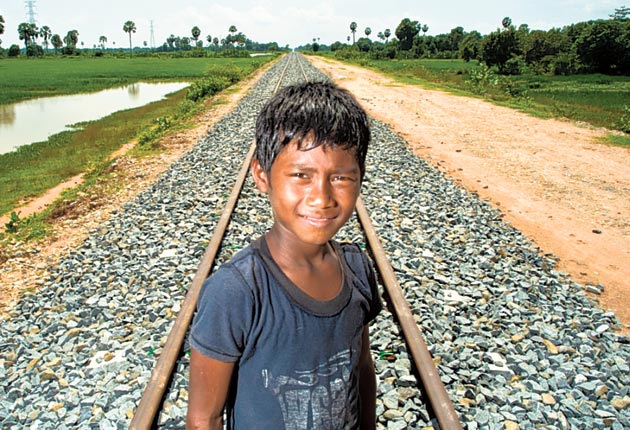'An off-peak return from Singapore to Scotland...'
Cambodia provides 'missing link' in Iron Silk Road rail project

Your support helps us to tell the story
From reproductive rights to climate change to Big Tech, The Independent is on the ground when the story is developing. Whether it's investigating the financials of Elon Musk's pro-Trump PAC or producing our latest documentary, 'The A Word', which shines a light on the American women fighting for reproductive rights, we know how important it is to parse out the facts from the messaging.
At such a critical moment in US history, we need reporters on the ground. Your donation allows us to keep sending journalists to speak to both sides of the story.
The Independent is trusted by Americans across the entire political spectrum. And unlike many other quality news outlets, we choose not to lock Americans out of our reporting and analysis with paywalls. We believe quality journalism should be available to everyone, paid for by those who can afford it.
Your support makes all the difference.Cambodia's railway – for so long the victim of war, turmoil and the neglect that has beset the country – is poised to get moving again.
Officials yesterday formally opened the first section of a new network that will stretch across the country and provide the missing link in a rail route that could reach from Scotland to Singapore. It could provide a major boost for Cambodian industry.
"We are on the cusp of a contiguous Iron Silk Road stretching from Singapore to Scotland," Kunio Senga, a senior official with the Asian Development Bank (ADB), declared at the launch. "This possibility has been talked about for decades, but today the dream has finally taken a big step toward becoming reality."
French colonial rulers were the first to lay rail tracks in Cambodia, starting in the 1920s. By 1969, the network had two tracks and reached from the Thai border to the capital, Phnom Penh, and then carried on to the coast at Sihanoukville.
But by then Cambodia was immersed in war and chaos. A US-backed coup saw the overthrow of the government of Prince Sihanouk, while Maoist-inspired Khmer Rouge steadily advanced on Phnom Penh.
By April 1975, the rebels had seized control of the country and set in place a system of forced agricultural labour camps. Hundreds of thousands of people were killed or else died from starvation and disease.
Even after the Khmer Rouge were forced from power, the southern line that linked Phnom Penh with the coast remained perilous. In 1994, three Western tourists, David Wilson of Australia, Briton Mark Slater and Jean-Michel Braquet of France, were seized from the train by Khmer Rouge fighters and killed.
The railway also faced a slow, steady decline as a lack of investment and maintenance. Across much of the network, crumbling stations and rusted locomotives effectively destroyed the service.
Even today, in many parts of Cambodia the only thing riding on the tracks are bamboo-made carts or lorries, powered by small engines.
These homemade vehicles transport people and cargo at a slow pace, but only on short journeys. Things got so bad that last November the government declared the system shut and awarded a 30 year contract to an Australian company, Toll, to refurbish and operate the network. To enable this, the Government of Cambodia received a loan of $84m from the ADB.
Earlier this month, after investment in new rails, signs, locomotive repairs and training of the fledgling workforce, a freight service to Touk Meas, near the border with Vietnam, began operating ahead of yesterday's inauguration. The entire railroad network, covering more than 400 miles, is due to be ready by 2013.
"Upgrading the infrastructure will improve competitiveness in Cambodia's economy and promote direct investment in Cambodia itself," said Putu Kamayana, director of the ADB's Cambodian office.
Once Cambodia's railway is completed, just one outstanding link – between Phnom Penh and Vietnam's Ho Chi Minh city – will remain for a pan-Asian network to be ready. That network will help provide better links between the countries of south-east Asia and markets in China.
But not everyone in Cambodia is thrilled by the new railway. Indeed, many of the thousands of people who live alongside the tracks and scratch a living by selling goods believe they could be forced from their homes as the tracks are developed. Others, like the operators of the bamboo lorries, which have become a tourist attraction in their own right, could lose their livelihoods. The ADB has said $3.5m has been set aside to compensate such people.
Prak Pheam, 31, who lives north of Phnom Penh, told the Associated Press the new railroad would put his bamboo train out of business.
In a good week he can earn up to $25, but only a handful of bamboo drivers have been told they would receive compensation. Few understand how to apply for the money.
"It's unfair that I'm not getting money," he said. "I'll have to go back to the rice fields. Or get a job on a train."
Join our commenting forum
Join thought-provoking conversations, follow other Independent readers and see their replies
Comments